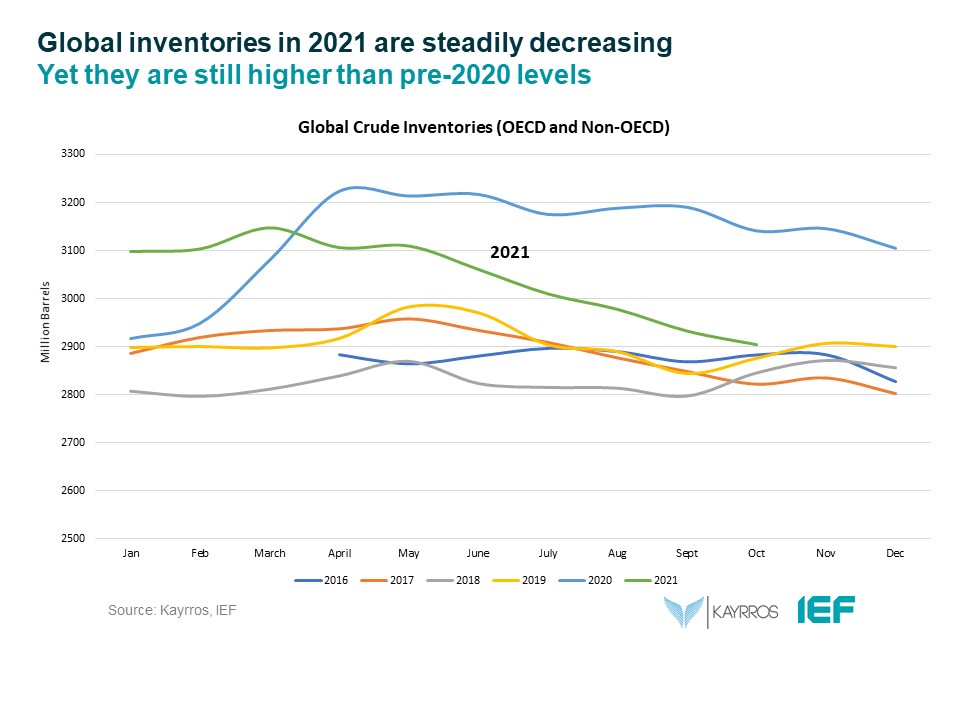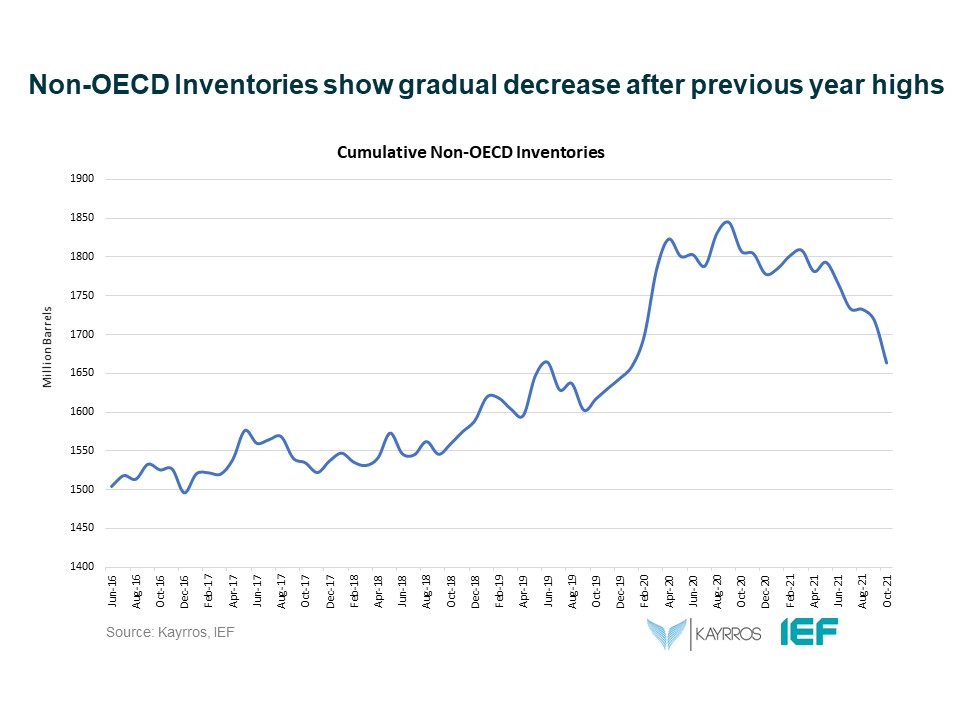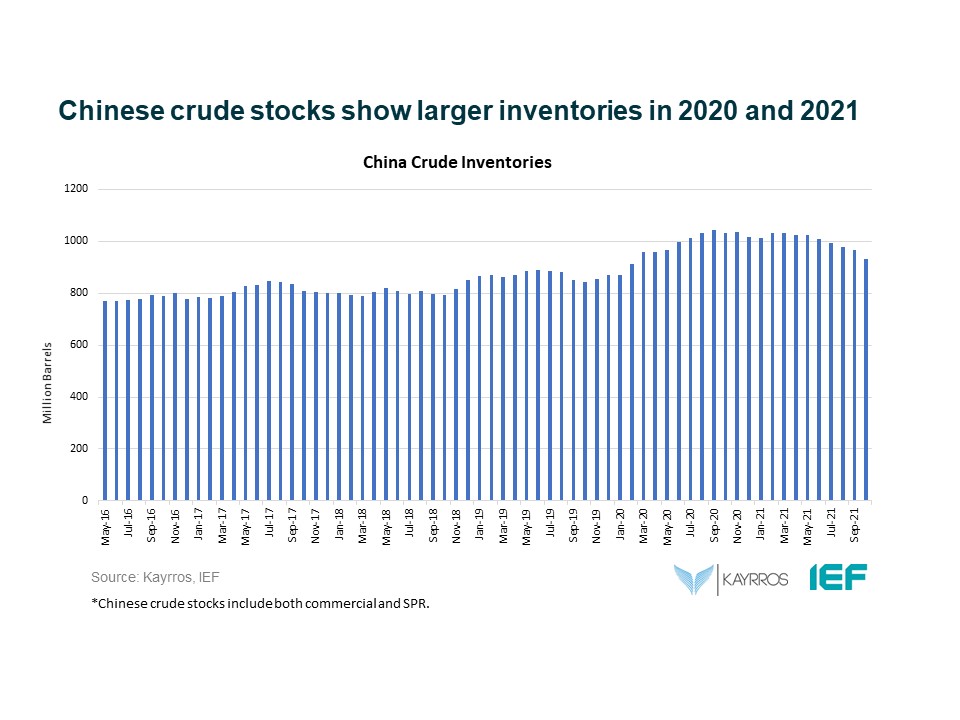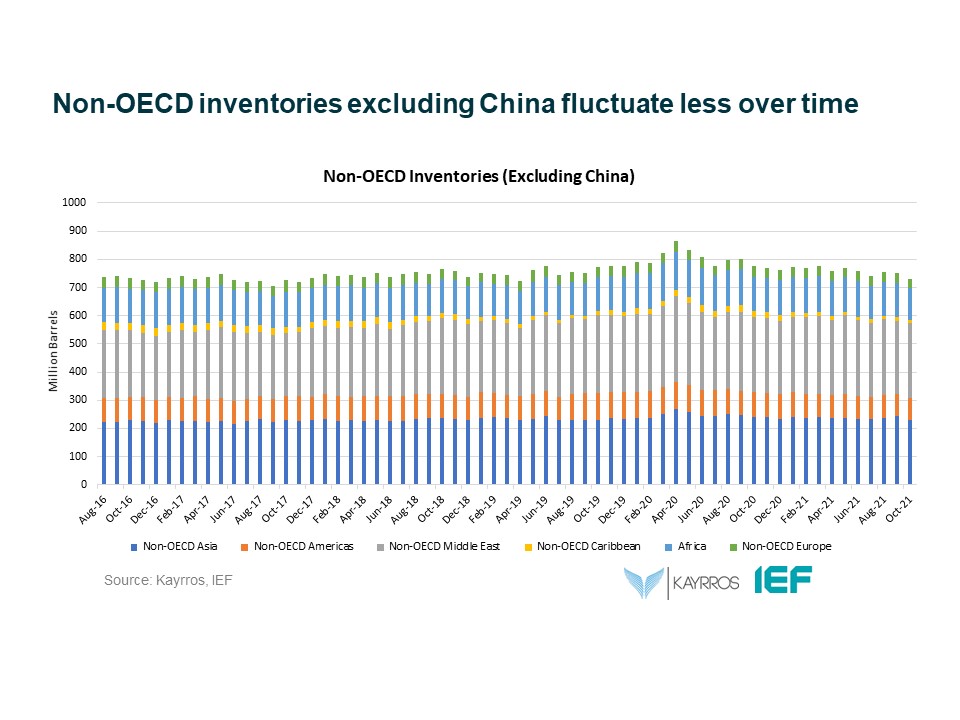Comparative Analysis of Monthly Reports on the Oil Market
1. International Policy and Market Context
G20 Leaders Reaffirm Collaboration with the IEF on Energy Climate and Transitions
- G20 Leaders gathered in Rome under the G20 Presidency of Italy on 30-31 October called on the IEF to intensify dialogue and collaboration between producers and consumers to bolster the efficiency, transparency, and stability of the energy markets. Both the IEF and G20 remain committed to maintaining energy security, while addressing climate change in just and orderly transitions that work for all.
COP26 Reaches Consensus to Address Climate Change
- Countries struck an agreement on 13 November to combat climate change reflected in the "Glasgow Climate Pact." Highlights from the agreement include:
- Strengthening emissions-reduction targets by the end of next year keeping global warming well under 2 degrees Celsius, and close to 1.5 degrees, by the end of the century compared with preindustrial-era temperatures.
- An agreement to reduce reliance on coal and inefficient fossil fuel subsidies that cause wasteful consumption.
- Urging developed countries to at least double their collective provision of climate finance for adaptation to developing countries from 2019 levels by 2025.
- New rules for trading carbon credits between countries, allowing governments to achieve their emissions goals by funding emissions reduction projects in another country.
US EIA Forecasts Rising Inventories in Early 2022
- According to its latest short-term market outlook, the US EIA forecasts a return to inventory builds around the first half of 2022. The combination of production adjustments from OPEC+ nations, higher production from US producers and slower growth in global oil demand would see supply outpacing demand for the first time since the second quarter of 2020. The EIA sees non-OPEC growth at 3.23 mb/d in 2022 compared to 3.02 mb/d for OPEC and 3.06 mb/d for the IEA.
22nd OPEC and non-OPEC Meeting reaffirms production adjustments
- On 4 November, OPEC and non-OPEC countries reconfirmed the production adjustment plan and the monthly production adjustment mechanism approved at the 19th OPEC and non-OPEC Ministerial Meeting on 18 July and decided to adjust the monthly overall production by 0.4 mb/d for the month of December 2021. The 23rd OPEC and non-OPEC Ministerial Meeting is scheduled for 2 December 2021.
2. Key Points
2.1 Demand
The IEA and OPEC lower 2021 oil demand growth assessments while EIA's rises.
- The IEA's demand growth assessment falls year-on-year (y-o-y) by 40 kb/d to 5.49 mb/d for 2021. Demand is expected to grow by 3.37 mb/d in 2022, the IEA reports.
- OPEC's y-o-y demand growth estimate falls by 170 kb/d to 5.65 mb/d this year. Next year it forecasts a growth of 4.15 mb/d.
- EIA's assessment rises by 60 kb/d for a growth of 5.11 mb/d this year and it sees growth of 3.35 mb/d in 2022. The IEA, OPEC, and EIA estimates for absolute world demand are now 96.28 mb/d, 96.44 mb/d, and 97.53 mb/d for 2021, respectively.
The IEA, OPEC and EIA converge on OECD growth but differ slightly on non-OECD demand growth in 2021.
- The IEA's assessment of y-o-y non-OECD demand growth falls by 90 kb/d to 2.99 mb/d, while OPEC also makes a downward revision of 120 kb/d for overall growth of 3.22 mb/d. EIA non-OECD demand growth rises by 30 kb/d for a growth of 2.75 mb/d.
- The IEA's estimate for OECD demand rises by 50 kb/d to 2.50 mb/d for 2021. EIA OECD growth also rises by 30 kb/d for a growth of 2.36 mb/d. OPEC OECD demand growth forecast falls by 40 kb/d for a growth of 2.44 mb/d.
- IEA and EIA assessments of OECD demand growth differ by 140 kb/d, while OPEC and EIA estimates of non-OECD demand growth differ by 470 kb/d.
2.2 Supply
The IEA and EIA make upward revisions on non-OPEC supply growth while OPEC remains static.
- The IEA's November assessment of non-OPEC supply rises by 110 kb/d for a total growth of 0.72 mb/d, while the EIA reports a slightly higher overall supply growth of 0.81 mb/d y-o-y, revised up by 140 kb/d from last month. OPEC non-OPEC supply growth remains the same as last month at 0.66 mb/d. Non-OPEC supply growth is expected to increase into 2022 with the IEA reporting growth at 3.06 mb/d, OPEC at 3.02 mb/d, and EIA at 3.23mb/d. In absolute values, the IEA, OPEC, and EIA estimate non-OPEC supply at 63.72 mb/d, 63.64 mb/d, and 64.29 mb/d, respectively for 2021.
- The IEA estimates OECD oil supply growth this year at 0.17 mb/d, OPEC pegs it at 0.21 mb/d, and EIA reports a growth of 0.38 mb/d, an increase of 110 kb/d, 30 kb/d, and 200 kb/d, respectively. In absolute terms, the IEA, OPEC, and EIA estimate OECD oil supply at 28.11 mb/d, 29.32 mb/d, and 31.11 mb/d, respectively for 2021. The difference between IEA and EIA on OECD supply growth is 210 kb/d.
The EIA reports higher non-OECD supply growth than the IEA and OPEC.
- The IEA's non-OECD supply growth assessment is revised up by 10 kb/d to 0.21 mb/d. OPEC's forecast reports a growth of 0.33 mb/d for 2021, which is revised down by 20 kb/d from last month. The EIA is more optimistic for non-OECD supply growth, forecasting a rise of 0.43 mb/d, a figure that was revised down by 50 kb/d from last month. OPEC and EIA report higher growth in 2022 at 1.61 mb/d and 1.45, respectively while the IEA forecasts growth at 1.21 mb/d.
- In absolute values, the IEA, OPEC, and EIA non-OECD supply estimates are 30.57 mb/d, 32.04 mb/d, and 33.18 mb/d, respectively for 2021. Divergence on total non-OECD supply growth is widest between the IEA and EIA, differing by 220 kb/d.
The IEA, OPEC, and EIA revise OPEC production estimates upwards for October.
- The IEA revised its OPEC production estimate upward by 240 kb/d month-on-month (m-o-m) to reach total production of 27.42 mb/d. OPEC's assessment of its own production was revised upwards by 220 kb/d to 27.45 mb/d. The EIA also increased its assessment by 240 kb/d for total OPEC crude production of 27.40 mb/d.
2.3 Stocks
The IEA, OPEC, and EIA continue to display strong alignment on stock figures which are now below the five-year average but still at or higher than 60 days forward cover.
- The IEA reports OECD stock levels at 2762 mb, which is close to OPEC's assessment of 2805 mb and EIA's assessment of 2782 mb. These are 250 mb, 206 mb, and 216 mb below the five-year average, respectively.
- According to the IEA, crude oil inventories drew by 25.4 mb while product stocks drew by 23.4 mb. Other oils, including NGLs and feedstocks drew by 2.8 mb. According to OPEC, crude oil stocks drew by 9.3 mb while products drew by 9.2 mb.
- EIA estimates OECD inventories dropped by 23 mb in September to 2782 mb – 216 mb below the five-year average.
- The widest divergence in inventories is between OPEC and the IEA which stands at 43 mb. Total US crude inventories (excluding SPR) amount to about 435 mb, according to the EIA, which is 7 percent below the five-year average for this time of year. OPEC reports US commercial crude oil stocks at about 434 mb and around 30 mb below the five-year average.
2.4 Snapshot (mb/d)

3. Global Analysis
3.1 Demand Data

3.2 Supply Data

3.3 Stock Data


IEF-Kayrros Stock Analysis:




JODI Data:

US crude oil closing stock levels in September fell further month-on-month by 4.36 mb to an 85-month-low of 1038.66 mb.

Korean crude oil closing stock levels in September fell further month-on-month by 1.85 kb to a 140-month low of 106.34 mb.

UK crude oil closing stock levels in September fell further month-on-month by 2.86 mb to 21.13 mb registering the lowest level since monitoring began in January 2002.

While its August figures were significantly revised downward, German crude oil closing stock levels in September rose month-on-month by 1.6 mb to 153.46 mb.
Explanatory Note
The IEF conducts a comprehensive comparative analysis of the short-, medium-, and long-term energy outlooks of the IEA OPEC, and the EIA to inform the IEA-IEF-OPEC Symposium on Energy Outlooks that the IEF hosts in Riyadh as part of the trilateral work programme on a yearly basis.
To inform IEF stakeholders on how perspectives on the oil market of both organisations evolve over time regularly, this monthly summary provides:
- An overview of key events and initiatives in the international policy and market context.
- Key findings and a snapshot overview of data points gained from comparing basic historical data and short-term forecasts of the IEA Oil Market Report, the OPEC Monthly Oil Market Report, and the EIA Short-term Energy Outlook.
- A comparative analysis of oil inventory data reported by the IEA, OPEC, and EIA, and secondary sources in collaboration with Kayrros (added in an updated report on the IEF website).
The International Energy Forum
The International Energy Forum is the leading global facilitator of dialogue between sovereign energy market participants. It incorporates members of International Energy Agency and the Organization of the Petroleum Exporting Countries, and also key players including China, India, Russia and South Africa. The forum's biennial ministerial meetings are the world's largest gathering of energy ministers, where discussions focus on global energy security and the transition towards a sustainable and inclusive energy future. The forum has a permanent secretariat of international staff based in the Diplomatic Quarter of Riyadh, Saudi Arabia. For more information visit www.ief.org.






